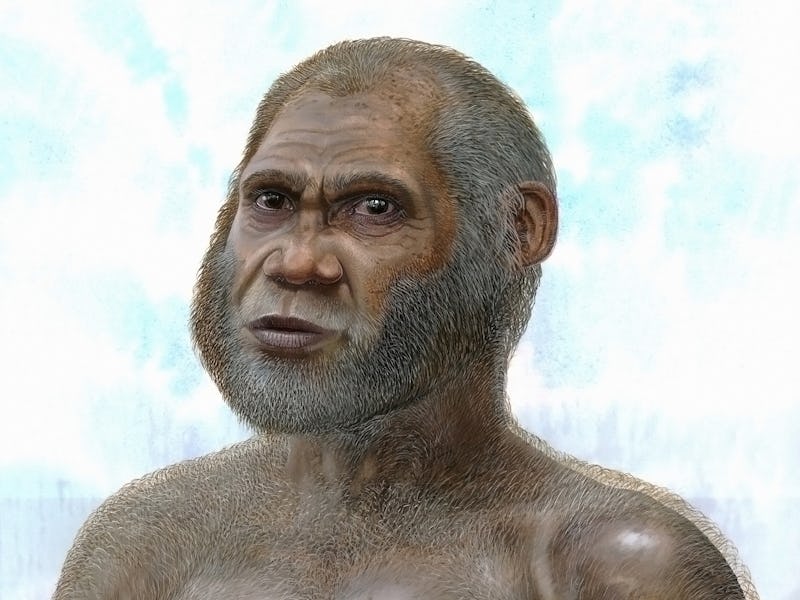Scientists Think This Ancient Human Lived Among Our Modern Cousins
"We're investing so much energy into searching for the signs of intelligent life in space, yet we still know so little about our own evolution."

A 14,000-year-old thigh bone from a Chinese cave is changing what we thought we knew about human evolution.
The bone matches the features of the most ancient beings of the Homo genus — pre-modern humans who lived 1.5 million years ago. The discovery was published this week in PLOS ONE.
Until now, archaeologists believed that these ancient protohumans died out 100,000 years ago in mainland Asia. Instead, this finding at least suggests pre-modern humans not only survived much, much longer than previously thought, but that they co-existed, and likely interbred, with modern humans for tens of thousands of years.
These pre-modern humans are known as the “red deer cave people:
The Red Deer Cave People were the most recent known prehistoric population that do not resemble modern humans.
“To find a human bone that resembles very ancient humans that is only around 14,000 years old is a real surprise,” Darren Curnoe of University of New South Wales Australia tells Inverse. Curnoe co-authored the study with Ji Xueping from the Yunnan Institute of Cultural Relics and Archaeology in China.
Study co-authors Ji Xueping and Darren Curnoe.
The finding adds to our understanding of the “Red Deer Cave people,” whose remains were first discovered in 1979 in caves in southwest China.
Although the femur in question very closely matches what we would expect from Homo habilis and early Homo erectus, Curnoe urges caution in drawing conclusions from a single bone specimen. But other evidence is also pointing archaeologists in a similar direction.
This is the thigh bone that caused all the fuss.
“If we place the new discovery into the broader context at Maludong [cave] we see that many other bones, especially the skull and jaw bones and teeth also point strongly towards an archaic species at the site,” says Curnoe. “So, we have quite a number of bones from different parts of the skeleton all pointing to a pre-modern group at the site.”
The researchers are trying to confirm their discovery through DNA testing, although efforts to date have been unsuccessful. “Unfortunately, the thigh bone shows signs of having being burnt and Maludong itself is in a tropical area, so it’s unlikely that any ancient human DNA would have survived,” he says.
The Red Deer Cave people likely represent a side branch of human evolution, rather than direct ancestors of humans living today, says Curnoe. Evidence of modern humans has been found in the fossil record dating back to 200,000 years ago.
Researchers map layers of the cave deposit at Maludong in China.
The question of why only one hominid species exists today, when several have existed at one point in the distant past, is still something archaeologists are grappling with.
“It’s hard to be sure of course as there’s so little evidence to go on,” says Curnoe. “Maludong potentially offers insights into this question because is the youngest example of a likely archaic human anywhere in the world, the next closest being the australopithecine-like Hobbit from Flores in Indonesia.
“If I had to guess, I would say that it was a combination of three things: The dramatic climate and environmental changes during the period 15,000-10,000 years ago; at the same time we also see a huge increase in the modern human population; and finally, many humans at this time, especially the ones who would go onto invent farming, began living a much more sedentary and crowded lifestyle and having a bigger impact on the environment than the strictly mobile hunter-gatherers did.”
Part of what makes this research so interesting, says Curnoe, is how little we actually know about our relatives of the not-too-distant past. “While today we are the only living human species, it wasn’t that long ago that we weren’t alone on the planet. We’re investing so much energy into searching for signs of intelligent life in space, yet we still know so little about it on Earth, about our own evolution, and that of our close and now extinct relatives.
“The search for the fossil remains of our ancestors offers us the chance to understand why we’re here and not them, and perhaps even what makes us so unique compared to other life, why we’re so intelligent.
“Who knows, it might even have something to tell us about where we might be headed as a species?”